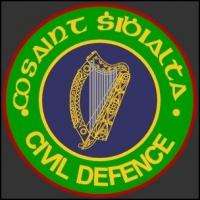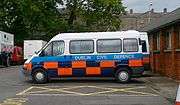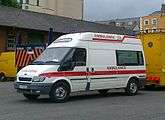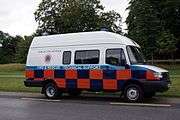Civil Defence Ireland
 | |
| Formation | 1950 |
|---|---|
| Legal status | Active |
| Headquarters | Roscrea, County Tipperary, Ireland |
Region served | Ireland |
Leadership | Civil Defence Board |
| Website | civildefence.ie |
| Remarks | Appointment: Minister for Defence & Local Authority |

Civil Defence Ireland (Irish: Cosaint Shibhialta na hÉireann) is the national civil defence organisation of Ireland. It is operated at local authority level in conjunction with the Department of Defence.
The organisation was established in 1950 in response to the threat of nuclear disaster posed by the atomic bomb following World War II or "The Emergency" as World War II was known in Ireland. Its purpose was to provide aid, assistance and disaster relief to citizens in time of emergency. Today, the organisation runs on the same principle with a focus on effectively aiding the full-time emergency services as and when required.
Organisation Structure
Civil Defence Ireland is composed almost entirely of volunteers, with the exception of the local authority-appointed Civil Defence Officers, Assistant Civil Defence Officers, administration, maintenance and stores personnel. The organisation provides five different services to the community, primarily acting as an auxiliary resource for the front-line emergency services, particularly the fire brigade rescue and ambulance service who may utilise the organisation's manpower, skills and equipment when requested.
Civil Defence Ireland - Rank Structure
| CD Officer | Asst.CD Officer | Commander | 1st Officer | 2nd Officer | 3rd Officer | Leader | Asst.Leader | Volunteer |
| Civil Defence Services/Disciplines* | ||
| Auxiliary Fire Service | Trained in firefighting and flood relief. | |
| Rescue Service | Trained to rescue individuals in emergency situations in a wide variety of disciplines Ranging from basic search to Urban rescue, heavy rescue and High-line/technical rescue. | |
| Casualty Service | Providers of emergency care at different levels in emergencies or Ambulance cover at events with fully trained first aid levels such as CFR, OFA, EFR, all the way through to EMT. | |
| Welfare Service | Provide care, comfort and shelter for personnel both domestic and foreign in emergencies as well as providing Logistics and support to same. | |
| Warden Service | Provide radio communications networks and radiological monitoring. | |
- Service structure is exclusive to Dublin and Cork city units. Most other Civil Defence units are divided by location, and train in some or all of the above disciplines as required by County needs.
Vehicles
The organisation uses many different types of vehicles. Some are purpose-built and some have been adapted into new roles such as mobile incident command units. Many of the vehicles have all-terrain capabilities such as Land Rover Defender field ambulances, Bedford and Iveco four-wheel drive lorries and Bandvagn 206 personnel carriers. Standard vehicles such as emergency ambulances and class B fire appliances are also available for use by their respective services. Vehicle livery is generally non-standardised orange and blue on a white background with the exception of Dublin Civil Defence who use fleet-standard orange/blue Battenburg markings over white paintwork on all new vehicles. The Water Rescue Unit have a fleet of inshore patrol vessels and rigid-hulled inflatable boats.
Uniforms
Following a redesign of the uniform in recent years there are now two main standard configurations of uniforms within the organisation, namely the Workwear No. 2 Uniform and the Service Dress No. 1 Uniform. All members of the organisation are issued with the standard Workwear No. 2 Uniform consisting of:
- Boots
- Bump Hat (Baseball Cap)
- Hi-Viz Vests
- Navy Combat Trousers
- Navy Open Necked Shirt
- Navy Waterproof Trousers
- Orange and Navy Waterproof Jackets
- Soft Shell Long Sleeved Jackets
- White Wicking T-Shirt
Also as a change from the normal practice within some areas of the organisation, instructions now clearly outline such uniform rules as "Badges/Decorations or any other items CANNOT be worn or attached to any item of the Workwear Uniform i.e. shirt, t-shirt, waterproof jacket, soft shell jacket."[1]
The No.1 Dress Uniform, is worn at certain occasions under the direction of the local Civil Defence Officer. The core components of the No. 1 Dress Uniform are:
- Navy Tunic
- Navy Trousers/Skirt
- White Long Sleeve Shirt
- Plain Navy Clip-on Tie
- White Lanyard
- Black Laced Footwear and Black Socks
- Cap/Beret (Officers wear a peaked cap in place of the beret.)
These core components are supplemented by some additional components for particular occasions such as White Gloves, White belt etc. as directed by the Civil Defence Officer.
While these are the main two configurations of uniforms there are also a number of other configurations for different specialist areas. For example members of the Auxiliary Fire Service are issued with firefighting jackets/trousers, gloves, fire boots and firefighter's helmets. Members of the rescue service wear a jumpsuit and safety boots/helmets. Members of the Water Rescue Unit are issued with drysuits, water rescue helmets and Personal Flotation Devices (PFDs).
Notable emergency calls
The Civil Defence can be activated by request from civil power (gardaí), local authority, fire services and the Health Service Executive. The organisation may also respond to incidents witnessed in active duty such as road traffic collisions. They may also respond to non-statutory requests at the discretion of the Civil Defence Officer.
Selected notable events in the organisation's history are:
- 1965 North Wall Depot Fire - firefighting support (in support of the Dublin Fire Brigade)
- 1981 Stardust fire - disaster relief (supporting Dublin Fire Brigade)
- 1984 Raglan House Explosion - firefighting and rescue (supporting Dublin Fire Brigade)
- 1995 Dublin/Wicklow Mountains Forest Fires - firefighting (supporting Dublin Fire Brigade)
- 2002 Flooding in Dublin's North Inner City - rescue and water pumping (supporting Dublin Fire Brigade)
- 2009 Adverse weather Nationwide - flood relief and water supply (supporting County Fire Services, Irish Defence Forces and Gardaí)
Civil Defence College
The Civil Defence College was initially based at Ratra House in Dublin's Phoenix Park before relocating to Roscrea, County Tipperary in 2006. The college is housed within the national headquarters of Civil Defence and serves to provide potential instructors with a level of education that will allow them to teach classes of volunteers to be competent in their service's skills. Courses include AFS Instructor, Radio Communications Operator/Instructor, Emergency First Responder and Emergency Medical Technician. The college is approved by the Pre-hospital Emergency Care Council (PHECC) to train members to practitioner (EMT) level and is approved to implement the 3rd edition Clinical Practice Guidelines (CPGs) set down by PHECC.
Gallery
- Civil Defence Vehicles and Equipment
-
Dublin Auxiliary Fire Service Dennis RS Fire Engine -
Dublin Civil Defence Incident Command Unit with battenburg markings -
Dublin Civil Defence Field Ambulance on Land Rover Defender Chassis -
Dublin Civil Defence 4x4 utility vehicle -

Dublin Civil Defence Minibus -

Dublin Civil Defence van-based Ambulance -

Dublin Auxiliary Fire Service Dennis RS Fire Engine -

Leyland Sherpa Fire & Rescue Support Vehicle, Dublin
See also
- History of the Republic of Ireland
- Dublin Fire Brigade
- PHECC
- Civil defense by country
- Irish Red Cross
- St. John Ambulance Brigade of Ireland
- Order of Malta Ambulance Corps
References
Notes
- ↑ "Civil Defence Circular, CD 02/2012, The Wearing of the Civil Defence Volunteer Uniform" (PDF). CivilDefence.ie. Retrieved 2012-06-25.